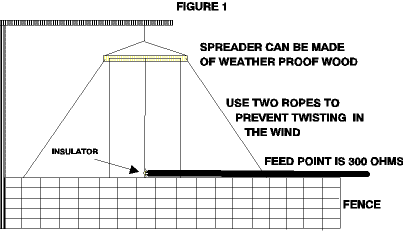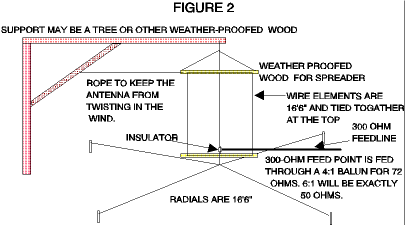Three Wire Vertical
SANS Tuner
As always, we just knew there must be a simple antenna which would fill the bill on 20. While looking through the ARRL handbook, we were interested in the vertical section. But, did not want to build an antenna which would require a tuner to match the final amplifier. It would be nice to have one that was broad band also. The virtues of the three-wire dipole were extolled, but how about using half the three wire dipole as a vertical? If the three wire dipole is 600-ohm fed, maybe the quarter wave three wire vertical would be 300-ohm impedance. I had never seen this type of vertical described before, but decided to give it a try.
Unwinding a field coil from a large speaker yielded plenty of copper wire of about #22 gauge. The first try was without insulators other than just a dry piece of wood about 18 inches long for the top support. Holes were drilled about six inches apart with the wire threaded through the holes and all connected together at the top of the vertical.
The lower outside ends were connected to the four-foot high fence in the back yard. The center element was hooked to the fence with an insulator. This was the feed point. Element length was 16″6″ long.
Worked at First Try
It worked at first try. It still had a reactance because a move of 20 kHz required re-tuning of the final amplifier. A quick try on the air brought a nice report from a W7 in Arizona. Maybe it was too low. So up the tree we went to raise the top to about 26 feet above ground. Another good report resulted from an Arizona station, but still with the same reactance problem.
Adjustments
There was now a long ground run to the top wire of the fence. Could it be we were not getting an ideal ground plane? Measuring off three 17-foot lengths of speaker wire and connecting them to the bottom of the antenna made the difference. Now the rig tuned up without any sign of reluctance. When tuned up on 14250 moving from 14300 down to 14200, the loading on the final did not vary more than 15 mils. I might add, the feedline was a half wave long at 20 meters.


Performance Check
Now a quick check to see if the performance had improved. I called K2IIO/VE8 and received a quick response from Larry with the report we were the only signal from the states he was hearing and with an S/9 report. Larry was at Cape Christian, Baffin Island, NWT working at a USCG Loran station.
Excellent Until TVI
This antenna was a joy to use and saw many hours of use until a TV receiver was purchased. Our nearest TV station was eighty miles away with some as far as one hundred miles. TV!!! Even the local oscillator of the RME 69 receiver destroyed reception when tuned to twenty meters.
Today, not too many rigs have 300-ohm output, so a 4:1 balun should bring the feed point down to about 75 ohms. It probably would work on a 50-ohm output since the SWR should not be much over 1.5:1.0. However, a 6:1 balun would take the 300-ohm feed point to 50 ohms.
Not Tornado Proof!
And yes, we solved the TVI by a move to an area with better signal coverage after a very unfriendly Iowa tornado removed all of our antennas and part of the house early one June morning.
Originally posted on the AntennaX Online Magazine by Glenn Thomas, W5INU
Last Updated : 16th March 2024
